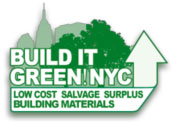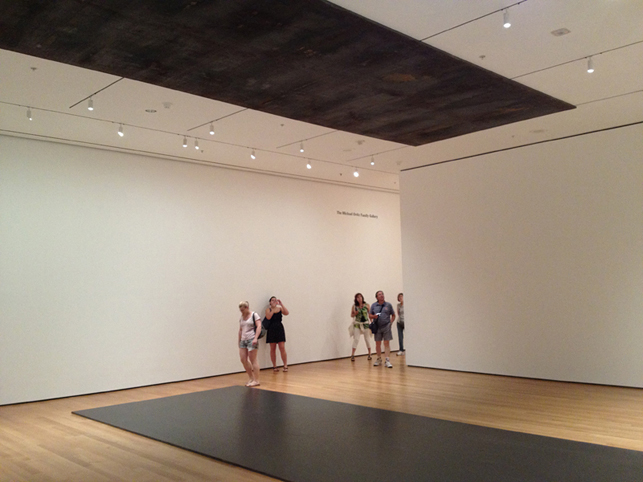 Green building can seem an oxymoron – any construction takes material and embodied energy. But we need homes, for protection and much more. So the greenest choice may be material that’s “in stock” – the adaptive re-use of an old building and salvaged items. Nationally, the Building Materials Reuse Association (BMRA) forwards the growth of this ideal. And on the local scene, Build It Green (BIG) turns around tons of building items every day. A re-used cabinetry set, for instance, may not look perfect – color’s off, a dent, it’s last years (or last decades) model – but in the end, it works – and by a truly green standard, it doesn’t get more perfect.
Green building can seem an oxymoron – any construction takes material and embodied energy. But we need homes, for protection and much more. So the greenest choice may be material that’s “in stock” – the adaptive re-use of an old building and salvaged items. Nationally, the Building Materials Reuse Association (BMRA) forwards the growth of this ideal. And on the local scene, Build It Green (BIG) turns around tons of building items every day. A re-used cabinetry set, for instance, may not look perfect – color’s off, a dent, it’s last years (or last decades) model – but in the end, it works – and by a truly green standard, it doesn’t get more perfect.
Coney Island Boardwalk, Brooklyn
Build It Green
Occupy Pine Street
 One block north of Wall Street in lower Manhattan is Pine Street. Why Pine – and in this ancient part of the city? Consider this. The Pine tree was a symbol on the earliest American flag. White Pine (Pinus Strobus) was the largest and tallest tree in the East. And it contributed to the American Revolution (coveted for ship masts). But its greatest value was as a framing lumber for building New York in the 1800’s. By the turn of the 20th c., the vast stands of majestic White Pine in the Northeast were gone – only to resurface a hundred and fifty years later through the demolition process.
One block north of Wall Street in lower Manhattan is Pine Street. Why Pine – and in this ancient part of the city? Consider this. The Pine tree was a symbol on the earliest American flag. White Pine (Pinus Strobus) was the largest and tallest tree in the East. And it contributed to the American Revolution (coveted for ship masts). But its greatest value was as a framing lumber for building New York in the 1800’s. By the turn of the 20th c., the vast stands of majestic White Pine in the Northeast were gone – only to resurface a hundred and fifty years later through the demolition process.
You Have No Idea
New York Magazine profiles generation twenty something in a recent issue – crediting a can do response to the economic downturn. As the story goes, well nurtured kids can beat a bleak economy. The furniture maker here, Devi Rawls, may have it as tough as many – expanded overhead, squeezed profits and no benefits. But despite it all, American woodworking, about the most long standing trades across the land, is growing.
“We work to become, not to acquire.” – Elbert Bubbard (1856-1915) American Philosopher and Writer
DELINEATED: Serra over Oak – MOMA
 The largest permanent installation at MOMA (Museum of Modern Art) isn’t art. Museum goers on the upper floors walk across a sprawling canvas of wood flooring – or more exactly, 4” tongue and groove engineered (veneer over plywood we’d expect) White Oak. It’s the expected choice, given factors of durability (hard wearing), cost (moderate) and aesthetics (a clear even grain that won’t divert from the art). Oak is like the gallery white wall, underfoot. But was it the best or only choice? Flooring specialists across different materials may call for a range of choices. But the natural warmth of wood, it’s ability to be both traditional and modern, and it’s abundance (at least with Oak, a relatively sustainable species), is part of why the wood product was specified. Would reclaimed wood be appropriate? Flooring grades with any degree of character marks – nail holes, knots, stress cracks, not to mention the currently popular “Dirty Top” (retaining the weathered surface of the wood), may raise some objections within the museum board and others. But a clear vertical grain heart Pine, a select grade of reclaimed Oak, or Ipe from the city boardwalks (another major American museum is considering the salvaged woods from the Coney Island boardwalk) may have been acceptable, potentially bringing a slightly richer hue and just enough character to connect with the art without diverting museum goers. The boards debate could then turn to getting the new installation under budget. Photo: Suzanne DeChillo/The New York Times
The largest permanent installation at MOMA (Museum of Modern Art) isn’t art. Museum goers on the upper floors walk across a sprawling canvas of wood flooring – or more exactly, 4” tongue and groove engineered (veneer over plywood we’d expect) White Oak. It’s the expected choice, given factors of durability (hard wearing), cost (moderate) and aesthetics (a clear even grain that won’t divert from the art). Oak is like the gallery white wall, underfoot. But was it the best or only choice? Flooring specialists across different materials may call for a range of choices. But the natural warmth of wood, it’s ability to be both traditional and modern, and it’s abundance (at least with Oak, a relatively sustainable species), is part of why the wood product was specified. Would reclaimed wood be appropriate? Flooring grades with any degree of character marks – nail holes, knots, stress cracks, not to mention the currently popular “Dirty Top” (retaining the weathered surface of the wood), may raise some objections within the museum board and others. But a clear vertical grain heart Pine, a select grade of reclaimed Oak, or Ipe from the city boardwalks (another major American museum is considering the salvaged woods from the Coney Island boardwalk) may have been acceptable, potentially bringing a slightly richer hue and just enough character to connect with the art without diverting museum goers. The boards debate could then turn to getting the new installation under budget. Photo: Suzanne DeChillo/The New York Times